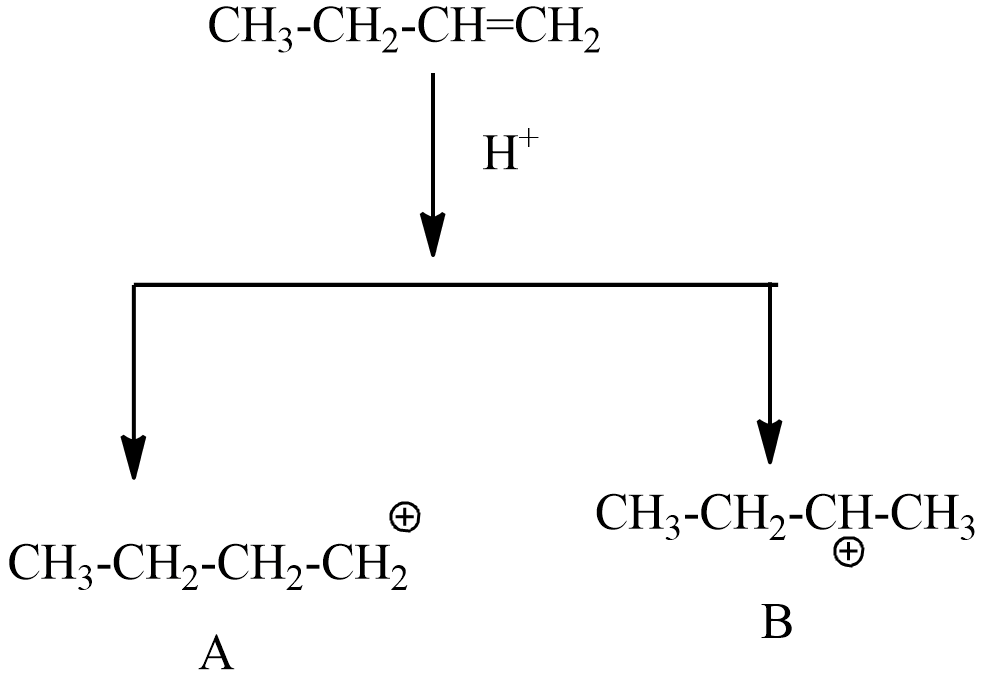
But-1-ene in reaction with HCl in the presence of sodium peroxide yields.
(A) n-butyl chloride
(B) Isobutyl chloride
(C) Secondary butyl chloride
(D) none of these
Answer
484.2k+ views
Hint: This reaction follows the Markovnikov rule in alkenes. This rule is one of the important rules for the prediction of the electrophilic addition reaction of unsymmetrical alkenes in organic chemistry. This rule mechanism mainly depends on the stability of carbocation and its structure also predicts the product conformational structure.
Complete step by step answer:
The given compound is But-1-ene. $C{{H}_{3}}-C{{H}_{2}}-CH=C{{H}_{2}}$
According to Markovnikov’s rule, the given alkene reacts with HCl in the presence of sodium peroxide follows,
$C{{H}_{3}}-C{{H}_{2}}-CH=C{{H}_{2}}+HCl\to C{{H}_{3}}-C{{H}_{2}}-C(Cl)H-C{{H}_{3}}$
The mechanism of the above reaction with electrophilic addition and obeying Markovnikov’s rule
Step-1: HCl dissociate into ions in the presence of sodium peroxide
\[HCl\to \underset{electrophile}{\mathop{{{H}^{+}}}}\,+\underset{nucleophile}{\mathop{C{{l}^{-}}}}\,\]
Step-2: the electrophile involves addition reaction with But-1-ene,

In this step, A=primary carbocation, B= secondary carbocation
Hence the stability of secondary carbocation is more stable than primary carbocation. So, the intermediate B, will continue the reaction by obeying markovnikov’s rule.
Step-3: intermediate B carbocation reacts with chloride ion and forms the product 2-chloro butane.

This 2-chloro butane is also known as secondary butyl chloride.
So, the correct answer is “Option C”.
Note: Markovnikov’s rule does not apply to symmetrical alkenes. Especially ethene is symmetrical alkene, this rule does not apply. Because, there is only one product from the electrophilic addition of HX to ethene. There is an AntiMarkovnikov's rule which includes that hydrogen atoms are attached to the carbon atom with the least hydrogen substituents. This rule explains the opposite of Markovnikov’s rule.
Complete step by step answer:
The given compound is But-1-ene. $C{{H}_{3}}-C{{H}_{2}}-CH=C{{H}_{2}}$
According to Markovnikov’s rule, the given alkene reacts with HCl in the presence of sodium peroxide follows,
$C{{H}_{3}}-C{{H}_{2}}-CH=C{{H}_{2}}+HCl\to C{{H}_{3}}-C{{H}_{2}}-C(Cl)H-C{{H}_{3}}$
The mechanism of the above reaction with electrophilic addition and obeying Markovnikov’s rule
Step-1: HCl dissociate into ions in the presence of sodium peroxide
\[HCl\to \underset{electrophile}{\mathop{{{H}^{+}}}}\,+\underset{nucleophile}{\mathop{C{{l}^{-}}}}\,\]
Step-2: the electrophile involves addition reaction with But-1-ene,

In this step, A=primary carbocation, B= secondary carbocation
Hence the stability of secondary carbocation is more stable than primary carbocation. So, the intermediate B, will continue the reaction by obeying markovnikov’s rule.
Step-3: intermediate B carbocation reacts with chloride ion and forms the product 2-chloro butane.

This 2-chloro butane is also known as secondary butyl chloride.
So, the correct answer is “Option C”.
Note: Markovnikov’s rule does not apply to symmetrical alkenes. Especially ethene is symmetrical alkene, this rule does not apply. Because, there is only one product from the electrophilic addition of HX to ethene. There is an AntiMarkovnikov's rule which includes that hydrogen atoms are attached to the carbon atom with the least hydrogen substituents. This rule explains the opposite of Markovnikov’s rule.
Recently Updated Pages
How do you factor x2 + x 20 0 class 9 maths CBSE

How do you solve y6x and 2x+3y20 using substitutio class 9 maths CBSE

Chipko movement originated in Gopeshwar in A 1953 B class 9 biology CBSE

The adjacent sides in the parallelogram are supplementary class 9 maths CBSE

The compound used in plastic industry is A Vinyl acetate class 9 chemistry CBSE

How do you solve for y in 2left y dfrac12 right 4left class 9 maths CBSE

Trending doubts
Types of lever in which effort is in between fulcrum class 12 physics CBSE

Distinguish between esterification and saponification class 12 chemistry CBSE

Which are the Top 10 Largest Countries of the World?

A two input XOR Gate produces a high output only when class 12 physics CBSE

Give five points to show the significance of varia class 12 biology CBSE

Which is the correct genotypic ratio of mendel dihybrid class 12 biology CBSE




